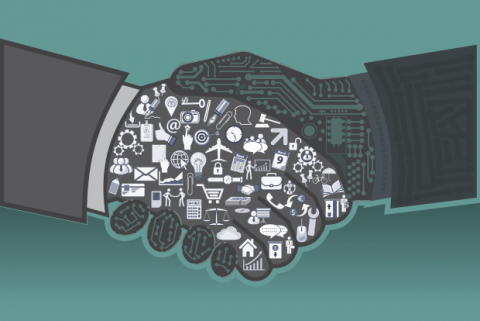At the start of the New Year, healthy IT organizations take time to reflect on the prior year’s accomplishments, value delivered, and objectives that were not achieved as planned. This exercise helps guide the planning, priority setting, budgeting, and staffing allocations for the upcoming year. As you progress through this iterative reflection and planning cycle, it’s important to center the conversations around the customer.
Research shows that successful organizations need to be good at three things: customer centricity, product/service leadership, and operational excellence. To be truly differentiated, however, you need to excel in one of these areas. As more people enter the global workforce as digital natives, and given the benefits enabled by the consumerization of IT, the expectation of the “technology experience” provided by corporate IT organizations is higher than ever.
Customer centricity is about staying close to your customers and having empathy for their experiences and pain points. As knowledge workers, our customers want to focus on their core responsibilities and priorities without the worry that the technology won’t work and the associated distractions. IT’s solutions and services should “just” enable and reliably improve the productivity of its user base.
[ Learn how leading CIOs are taking customer focus to the next level in this report from Harvard Business Review Analytic Services, The new rules of CIO leadership. ]
Customer centricity is also a mindset. When you think of IT as a service provider instead of a back-office “order-taking” organization, it’s easier to put the customer first in everything you do. Operational efficiency and delivering high-quality solutions/services begins with the customer in mind. This mindset ensures that customers receive the services from the organization that they need in order to be successful. Without it, you lose sight of what really matters.
Remember internal and external customers
Customer centricity is important regardless of whether your customers are internal or external. For example, if your customers are internal and you’re in the IT infrastructure domain, question whether the application team (or business user) would use your hosting services, or if they’d move to a cloud-based provider for their application hosting needs.
For your customers in another function, business unit, or division, if you are not yet operating within a robust IT-as-a-Service ecosystem, perform regular “showback” exercises where you transparently share with a business leader how much they would actually pay for the services provided for the previous month or quarter.
These are proven ways to test your user or customer sentiment, to determine if they’d recommend your IT organization or choose an external entity – and help the IT organization remember who their customers are. When you come to work thinking about the customer, you empower the IT team to do what’s right for customers. It helps to keep things real.
Discover the "golden thread"
Businesses ultimately exist to provide products and services to customers, and, of course, to be profitable while satisfying shareholder expectations and meeting regulatory and other external entities requirements. If you’re not in a sales or marketing role directly interacting with customers, however, sometimes it’s hard for people to understand who their customer is and how they contribute to their satisfaction.
Take the IT infrastructure team, for example. Its customer is often the applications team, but who’s the applications team’s customer? If you pull on that “golden thread,” you discover that it’s typically a business unit, such as sales, services, finance, manufacturing, or marketing. Further follow that thread along to discover who their customer is, and eventually it will lead to the customer who’s actually buying your company’s product or service. This exercise is easy and intuitive if you’re in product engineering or sales roles, but the further away you are from those functions, the more difficult it is to keep the customer top of mind.
This technique helps people understand who their direct customers are, to whom they’re a service provider, and ultimately how their everyday work contributes to the customer’s experience.
Two ways to reconnect with customers
I’ve found two approaches that have helped me, and my teams ensure we operate with a customer-centric mindset.
The first is “spending a day in the life of,” which can take on many forms. You could travel with the sales representative and observe a direct customer interaction; participate in an executive briefing center where a sales team brings in a customer and their decision makers for a corporate event; or visit a call center and shadow customer services agents to observe how they interact with the technology while interacting with customers.
In the last example, you’ll observe how intuitive IT’s applications are or are not. Sometimes solutions are designed by people who aren’t its users, and sometimes we think our solutions are intuitive and easy to use when maybe they’re not. We’ve all seen business users create their own applications or data sources to address gaps in solutions that an IT organization has delivered.
Spending “a day in the life of” also helps IT professionals become more innovative. There’s something about seeing people in their natural work environment that can’t be identified in a business requirement document or a design specification.
The second approach that helps folks reconnect with the customer is attending a functional or business unit forum like an all-hands meeting or a town hall. Sometimes hearing directly from a business leader about his or her priorities, pain points, and vision helps to connect the dots as to why some of the requirements that are later identified are so important. It’s helpful to keep things in context.
In the end, customer centricity is about understanding and prioritizing the customer. The more productive and efficient the knowledge workers are, hopefully enabled by technology provided by the IT organization, the more focused everyone can be on what really matters – how they contribute to the delivery of products and services to customers.
[ How can you build a more open and collaborative organization? Get the free eBook: The Open Organization Workbook, for advice from more than 25 leaders, consultants, and other practitioners. ]








Comments
Great information, as it makes total sense to perform a "day in the life of a customer" to get greater insight and connection on the high value needs of the customer.
Great insight Ken, Thanks for sharing your perspectives from your experiences. There are many examples where corporate IT organizations "push" technical solutions the never get adopted to the level that they should. Customer centricity solves this age old IT problem.